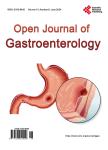Urinary Vascular Endothelial Growth Factor (VEGF) as a Novel Marker for Early Prediction of Esophageal Varices in Patients with Chronic Liver Disease
Urinary Vascular Endothelial Growth Factor (VEGF) as a Novel Marker for Early Prediction of Esophageal Varices in Patients with Chronic Liver Disease作者机构:Department of Medicine Cairo University Cairo Egypt Department of Chemical Pathology Cairo University Cairo Egypt Mataria Hospital Cairo Egypt
出 版 物:《Open Journal of Gastroenterology》 (肠胃病学期刊(英文))
年 卷 期:2017年第7卷第5期
页 面:141-153页
学科分类:1002[医学-临床医学] 100214[医学-肿瘤学] 10[医学]
主 题:Liver Cirrhosis Portal Hypertension Esophageal Varices VEGF Variceal Bleeding
摘 要:Background/Aims: Vascular Endothelial Growth Factor (VEGF) has a crucial role in portal hypertension and collateral vessels formation. This study aims to assess urinary VEGF in cirrhotic patients as a predictor of presence of esophageal varices, and variceal bleeding. Settings and Design: 42 cirrhotic patients were randomly selected and classified into 2 groups according to the presence of variceal bleeding. Methods and Material: Urinary VEGF was measured and corrected against urinary creatinine. Platelet count, liver functions, abdominal ultrasonography and upper endoscopy were done. Statistical Analysis Used: Comparison was done by Mann Whitney and Kruskal Wallis tests. Correlation was done using Spearman rank correlation. Multivariable logistic regression was done to identify predictors of variceal bleeding and presence of large varices. Receiver operator characteristic curve (ROC) analysis was used to determine the optimum cut off value of predictors. Results and Conclusions: Urinary VEGF was lower in cirrhotic patients with esophageal varices than those without. Low VEGF, low platelet count and splenomegaly were found to be independent predictors of both the presence of large esophageal varices, and variceal bleeding. Cut-off values for platelet count ≤ 166.3 × 103/μL, and corrected VEGF ≤ 59.12 pg/mg were predictive of large esophageal varices with 93.1%, 86.2% sensitivity and 74.5%, 58.2% specificity respectively. While variceal bleeding could be predicted at a platelet count ≤ 153 × 103/μL, and corrected VEGF ≤ 45.08 pg/mg with 90.9%, 81.8% sensitivity and 72.6%, 59.7% specificity respectively. The study concludes that urinary VEGF can be used as an alternative to upper endoscopic screening.



